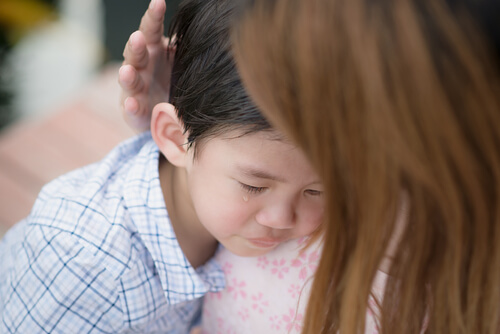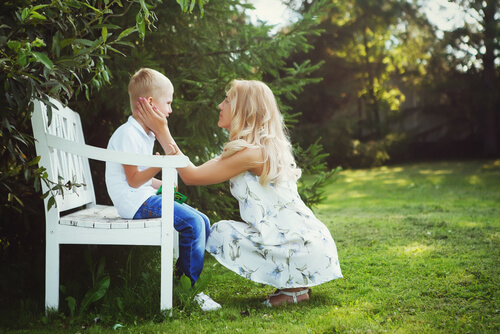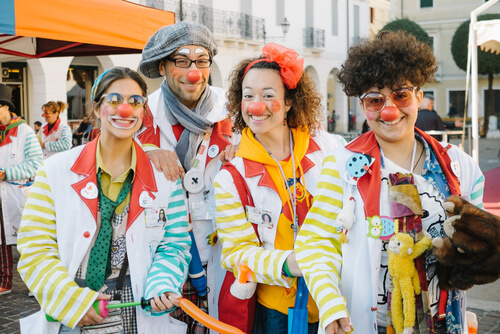Sometimes the Best Cure is a Mother's Love

When a child is ill, one of the major factors in their recovery will be the care, attention and pampering that we can provide them with. In other words, a mother’s love can be the best cure for a small child.
You’ll certainly remember times in your childhood when you were ill. But what exactly do you remember about those times?
In general, we usually remember the person who was there for us, rather than whatever we happened to be suffering from. And so, when we look back, we recall all those fond memories of love and care that helped us recover.
Love: the best cure
As human beings we function through our emotions and feelings. Since our intangible world is even more complex than the physical world around us, we often need to use strategy to achieve whatever is in our hearts.
The fact of the matter is that our emotional world is a huge part of our lives. In fact, it is proven that love and affection give us the stability and well-being that we so need every day.
We constantly demand attention, in one way or another. Once we receive it, we notice its effects both at a psychological level and also in our physical health.
When a child falls and gets hurt, the first thing he does is burst into tears, crying out for comfort and assistance. The first thing we normally do is take the child quickly in our arms and try to help him.
So, in this way we give priority to the physical aspect (a wound, a bump etc). Once we consider that the situation is “under control,” we unconsciously seek to comfort him, giving him our love so that he feels safe and regains his calm.
This reflects one of the most basic aspects of the human being: protecting the child in order to preserve the species.
The best cure is one that:
Relieves pain both physically and mentally.
Provides calm and helps to lessen the effects of the fright.
Transmits protection.
Tries to comfort.
Gives company.
What can you do as a mother?
It’s important not to show fear or to succumb to panic. In some situations it can be really difficult to stay calm when a child is hurt.
What we really need to do, though, is to act quickly. We simply need to be there to protect them and provide them with all the support they need.
A reassuring word or phrase will convey the calm that the child needs. Our tone of voice should try to be as calm as possible.
In this way we’ll be able to create an atmosphere of peace and protection. Another vital element is to give them the caresses they need in order to transmit that calm.
You can’t prevent kids from hurting themselves but you can prevent them from feeling unprotected. Transmit strength combined with positive attitudes in all emergency situations.

Things you should avoid
Unfortunately, many parents lose control and are overcome by fear. They cover their mouths, have fear etched all over their faces, and scream and cry.
Far from calming the child down and seeking to help him, what they are really doing is feeding their child’s feelings of vulnerability, pain and total insecurity.
The extremes of panic and total indifference are things we should avoid for the sake of our little ones. Indifference doesn’t allow the child to explore his pain, and certainly won’t let him feel loved and protected.
Many parents choose to take a cold, distant and indifferent attitude when their children (especially the youngest) break into tears.
They believe that if they leave them it will make them stronger. They think it will encourage their independence. But, in fact, quite the opposite is true.
Pain acquires an identity from the perception and expression of the parents. It is very important to have a good attitude in situations of pain, accidents or similar instances.
In this way we’ll be able to instill in our children the ability to face these situations in the least traumatic way. By doing this, we’ll avoid damaging consequences in the future.
The best cure we can give our little ones is to have enough emotional intelligence to become their support when everything around them causes them so much fear and brings them insecurity. We can empower the little ones to move forward.
Other types of cures
Different research studies have shown that love and affection produce very positive results in patients and individuals in general. A group of hospital patients between 12 months and 12 years of age took part in a fascinating study.
The results showed that the loving care provided to them helped them improve their health condition by more than 45%.
In fact, the great success of the so-called “hospital clowns” lies in how wonderfully they are received by young children. Not to mention the positive results obtained thanks to their efforts.
By improving the mood of patients, hospital clowns help facilitate the recovery process.

Doctor Yaso is a Venezuelan non-profit charity whose objective is to alleviate the suffering of hospitalized children, regardless of their condition.
Initiatives such as those of Doctor Yaso, allow children to feel better when they are hospitalized, since they provide them with a laugh and a fun time.
They aim to provide a good dose of affection, attention and, above all, the provision of quality time to help the children heal.
When parents and/or relatives need a break from looking after their child, the best option is a hospital clown.
Of course, it’s not necessary for the child to be hospitalized in order to receive this kind of attention. In fact, many groups of clowns offer entertainment sessions at home.
Love and affection are the magic ingredients that can help remove all of a child’s discomfort. It reminds us that everything will pass with time.
A gesture, a phrase, a look, a caress, a kiss or a hug help as much or more than medication. The key is to know how to balance both aspects.
The best cure is the humane, close, affectionate and caring treatment, be it that of mom, dad, or other relatives or friends.
All cited sources were thoroughly reviewed by our team to ensure their quality, reliability, currency, and validity. The bibliography of this article was considered reliable and of academic or scientific accuracy.
- Bowlby, J. (1986). Vínculos afectivos: formación, desarrollo y pérdida. Madrid: Morata.
- Bowlby, J. (1995). Teoría del apego. Lebovici, Weil-HalpernF.
- Garrido-Rojas, L. (2006). Apego, emoción y regulación emocional. Implicaciones para la salud. Revista latinoamericana de psicología, 38(3), 493-507. https://www.redalyc.org/pdf/805/80538304.pdf
- Marrone, M., Diamond, N., Juri, L., & Bleichmar, H. (2001). La teoría del apego: un enfoque actual. Madrid: Psimática.
- Moneta, M. (2003). El Apego. Aspectos clínicos y psicobiológicos de la díada madre-hijo. Santiago: Cuatro Vientos